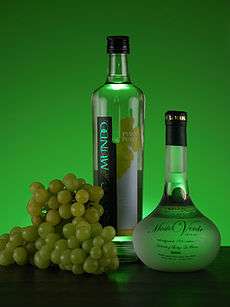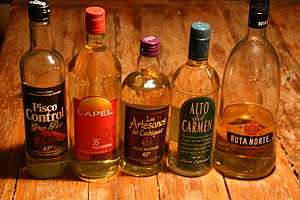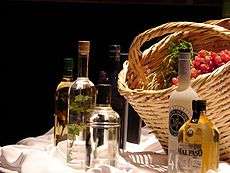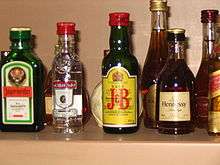Pisco
.jpg)
Pisco is a colorless or yellowish-to-amber colored brandy produced in winemaking regions of Peru and Chile.[1] Made by distilling grape wine into a high-proof spirit, it was developed by 16th century Spanish settlers as an alternative to orujo, a pomace brandy that was being imported from Spain.[2] It had the advantages of being produced from abundant domestically grown fruit and reducing the volume of alcoholic beverages transported to remote locations.[3]
Annual pisco production in 2013 reached 30 million litres in Chile and 9.5 million litres in Peru.[4][5]
Etymology
The oldest use of the word pisco to denote Peruvian aguardiente dates from 1764.[6] However, there are several, often nationalist theories about the origin of the word pisco. Pisco may have received its Quechua name from the Peruvian town of Pisco – once an important colonial port for the exportation of viticultural products[7] – located on the coast of Peru in the valley of Pisco, by the river with the same name.[8] Chilean linguist Rodolfo Lenz claimed that the word pisco was used all along the Pacific coast of the Americas from Arauco to Guatemala and that the word would be of Quechua origin meaning "bird".[9]
This claim is disputed by Chilean linguist Mario Ferreccio Podesta who supports the former Real Academia Española etymology that said that pisco was originally a word for a mud container.[9] However, the Real Academia Española actually supports the Lenz theory and underlines the Quechua origin.[9]
Other origins for the word pisco have been explored, including a Mapudungun etymology where "pishku" has been interpreted as "something boiled in a pot," which would in this hypothesis relate to the concept of burned wine (Spanish: vino quemado).[9]
The term influenced the Mexican Spanish use of the slang term pisto to denote distilled spirits generally.
History
Early aguardientes
Unlike the land in most of the Viceroyalty of New Spain, where only very few vineyards were established (mostly for the production of sacramental wine), some locations in the Viceroyalty of Peru—what is today Peru, Bolivia and Chile—were quite suitable for growing grape vines. By 1560 Peru was already producing wine for commerce; over time, a significant wine industry arose in the region.[10][11] It grew sufficiently strong and threatening to the Spanish mercantilist policies that in 1595 the Spanish Crown banned the establishment of new vineyards in the Americas to protect the exports of its native wine industry; however, this order was largely ignored.[11] As further protectionist measures, the Crown forbade exportation of Peruvian wine to Panama in 1614 and Guatemala in 1615.[11]
Distillation of the wine into pisco began in earnest around the turn of the 17th century, perhaps in response to these pressures.[11] Until the early 18th century, however, most aguardiente was still primarily used to fortify wine, in order to prevent its oxidation, rather than drunk on its own. This method of conservation corresponds with fortified wines that were shipped to Italy and Spain from other parts of the world (e.g. wines from Madeira and Marsala).
In the 17th century production and consumption of wine and pisco were stimulated by the mining activities in Potosí, by then the largest city in the New World.[11][12]
Recession of Peruvian pisco
The entire southern coast of Peru was struck by the 1687 Peru earthquake, which destroyed the cities of Villa de Pisco and Ica. Wine cellars in the affected area collapsed and mud containers broke, causing the nation's wine-growing industry to collapse.[6][9]
Still, in the early 18th century wine production in Peru exceeded that of pisco. By 1764, pisco production dwarfed that of wine, representing 90% of the grape beverages prepared.[6] With the suppression of the Society of Jesus in Spanish America, Jesuit vineyards were auctioned off, and new owners typically did not have the same expertise as the Jesuits – leading to a production decline.[6]
In the late 18th century the Spanish Crown allowed the production of rum in Peru, which was cheaper and of lower quality than pisco.[6]
Peru
In the 19th century demand for cotton in industrialized Europe caused many Peruvian winegrowers to shift away from vineyards to more lucrative cotton planting, contributing further to the decline of wine production and the pisco industry which depended on it.[9] This was particularly true during the time of the American Civil War (1861–1865) when the cotton prices skyrocketed due to the Blockade of the South and its cotton fields.[6]
Pisco was also popular in San Francisco and nearby areas of California during the Gold Rush in the late 1800s and early 1900s.[13]
Variants
Peruvian pisco

Peruvian Pisco must be made in the country’s five official D.O. (Denomination of Origin) departments—Lima, Ica, Arequipa, Moquegua and Tacna (only in the valleys of Locumba Locumba, Sama and Caplina)— established in 1991 by the government.
In Peru, pisco is produced only using copper pot stills, like single malt Scotch whiskies, rather than continuous stills like most vodkas. Unlike the Chilean variety, Peruvian pisco is never diluted after it is distilled and enters the bottle directly at its distillation strength.[14] For the production of a regular Peruvian Pisco bottle is required 8 kilograms of grapes and for the production of a Mosto Verde variety is necessary 12 kilograms of grape [15]
Many types of grapes were used to produce pisco, leading to a wide variation in flavor, aroma, viscosity and appearance of the liquor. This harmed attempts to export the product under a single denomination, resulting in numerous regulations setting a baseline for a product to carry the name. Four distinct types of pisco were thus designated:[16]
- Puro (Pure), made from a single variety of grape, mostly Quebranta, although Mollar or Common Black can be used; however, no blending between varieties is accepted ("pure" pisco should contain only one variety of grape).
- Aromáticas (Aromatic), made from Muscat or Muscat-derived grape varieties, and also from Albilla, Italia and Torontel grape varieties; once again, the pisco should only contain one variety of grape in any production lot.
- Mosto Verde (Green Must), distilled from partially fermented must, this must be distilled before the fermentation process has completely transformed sugars into alcohol.
- Acholado (Multivarietal), blended from the must of several varieties of grape.
Some other specific restrictions of note are:
- Aging: Pisco must be aged for a minimum of three months in vessels of "glass, stainless steel or any other material which does not alter its physical, chemical or organic properties".
- Additives: No additives of any kind may be added to the pisco that could alter its flavor, odor, appearance or alcoholic proof.
Peru currently exports three times more Pisco than Chile. Peruvian Pisco won over 20 gold medals and was named the best liquor of the world in the Concours Mondial de Bruxelles 2011.[17]
Chilean pisco

Chilean Pisco must be made in the country’s two official D.O. (Denomination of Origin) regions—Atacama and Coquimbo—established in 1931 by the government. Most of it is produced with a "boutique" type of distillate made by the Aguirre family among other producers. Others types are produced with double distillation in copper and other materials.
During the adaptation of many vineyards to pisco production, the most widespread grape was used as raw material, namely the Muscat, with some vineyards preferring the Torontel and Pedro Jiménez varieties. As is the case with Peru, regulations for pisco designations have been enacted in Chile, including the following classifications:
Regulation for pisco producing in Chile is quite high. Chilean distilleries are required to grow their own grapes and are grouped into two categories based in aromatic expressiveness: Muscat types (Pink Muscat, Muscat of Alexandria) are very fragrant, while Pedro Jiménez, Moscatel de Asturia and Torontel are more subtle.[19]
The Special and Reserve variations are very similar in flavor and color, both being subtly sweet and of a clear birch to transparent color. The flavor is much stronger than regular pisco with aromatic refreshing tones.
Ecological concerns
Chile has taken steps to have a clean and environmentally friendly production of pisco. In order to crack down on pollution, and to increase competitiveness, the National Council for Clean Production agreed with the pisco producers and pisco grape agronomists, to collaborate, signing an Agreement of Clean Production (APL). Capel, by itself invested more than CL$ 800 million.[20]
Peru's production of Pisco remains artisanal and do not alter the physical, chemical or organic properties before bottling. The pisco must be bottled directly after aging, without alteration or adding any product which could alter the odor, flavor or appearance.
Appellation of origin
The right to use an appellation of origin for pisco is hotly contested between Peru and Chile. Peru claims the exclusive right. In 2013, Pisco has been recognized as a Peruvian geographical indication by European Union, without prejudice to the use of the name "Pisco" for products originating in Chile protected under the Association Agreement between the Union and Chile of 2002.[21][22] However, various large-market countries (e.g., the United States,[1] France,[23][24] Italy,[23][25] Mexico,[23][26] Canada,[27][28] Australia,[29] etc.) allow products of Peru and Chile to be identified as "Pisco".
Peru argues the word "pisco" has a close relationship with the geographical area where it is produced, as Champagne in France, and thus should be used only by the liquor produced in Peru. El Salvador and the European Union recognize the exclusive Peruvian origin of Pisco.
It claims pisco was developed in its territory, citing many historical and etymological sources:
- Historical documents about the origin of the word "pisco", "pisko" or "pisko", applied to pre-Inca hunter-gatherer settlements.
- To the age of the term and the multitude of applications of the same : a "bird", a "valley", a " river", a port, to liquor, and to a vessel.
- To the application of the term to a city for over twenty centuries: Pisco.
Chile, however, regards the term "pisco" as generic, and it argues the spirit is simply a type of alcoholic beverage made from grapes (as in the case of whisky and vodka). It cites the name being used to designate a similar grape brandy produced in both countries and maintains two regions of Chile, Atacama and Coquimbo, are legally bound to use the term.[30]
Cocktails

Some of the most popular cocktails with pisco include:
- Pisco Punch, the first known pisco cocktail, invented in San Francisco, California in the 19th century. It contains pineapple, gum arabic, and syrup, among other ingredients.[31]
- Pisco Sour, which originated in Lima, is prepared with egg white, lime juice, simple syrup, and bitters. The Chilean version usually has no bitters.[32]
- Serena Libre, sweeter than Pisco Sour, made with Chilean papaya juice and sugar.
- Pisquiña, very simillar to Caipirinha, it has Pisco, Chilean Pica lemon, white sugar and ice.
- Mojito de Cuma, a Chilean version of a cocktail similar to Mojito, is made with Pisco, Sprite, Seven Up or a similar soda and mint leaves. Thanks to those soda's sweetness, it doesn't require sugar.
- Piscola Blanca, a variation of Piscola in Chile with clear sodas.
- Pisagua Chilean Pisco with carbonated water.
- Pischela, another variation of Chilean Piscola, similar to a British "submarine" it is Pisco with beer, preferably a blonde beer.
- Terremoto, a traditional Chilean cocktail made of Pipeño strengthened with Pisco, Fernet (optional), pineapple ice cream and Grenadine syrup.
- Piscoffee, Pisco with iced coffee and ice. Also is a variation of Irish Coffee with pisco instead of whiskey.
- Cóctel de Algarrobina, Peruvian Pisco with algarrobina syrup (or carob syrup), cinnamon, egg yolk, and cream.
- Pisco Flip, a flip on the traditional Pisco Sour, made with egg yolks instead of whites.[33]
- Cupid's Cup, Peruvian pisco, aperol, fresh lemon juice, simple syrup, and egg whites. A thyme sprig is used for decoration.[34]
- Tampisco Bay, a cocktail inspired by Tampa Bay, Florida. Made using Pisco and fresh cucumber juice, agave nectar, jalapeño slices, and red bell pepper slices and served in an ice filled highball glass.[35]
Mixed drinks
Some examples of mixed drinks with pisco include:
- Canario
- Capitán
- Chilcano de Pisco, a Peruvian cocktail made with Pisco, lemon juice, ice, bitters, and ginger ale.
- Piscola, also called "national cocktail" in Chile (Spanish: Combinado nacional or combinado) a cocktail prepared mixing Coca-Cola and pisco. Other combinations of Pisco and cola include the Perú Libre differentiating the same drink made with different origin piscos.
- Pisco Sorpresa, a cocktail originated in East London, inspired by the Latin American classic. Involves shaking gin, Cointreau, triple sec, Bacardi and Pisco, adding raspberry juice, pouring into a cocktail glass and finishing off with a dash of soda, grenadine and a squeeze of lemon.
- Piscotheque
- Roller Pisco
- Don Alfredo, a Peruvian cocktail made with mosto verde Pisco, Saint Germain, lime juice, ice and soda water.
Consumption
Per capita consumption of pisco in Chile is 3 litres per year, of which an average of 18% is spent on premium piscos.[36] Peruvian annual per capita consumption was reported in 2008 as 0.5 litres and growing (at the expense of market shares for rum and whisky, although whisky remains the most popular spirit in Peru).[37] Recent reports mention also an increase per year on 3,5 millions of liters produced for Peruvian market.[38]
The top importer of Peruvian Pisco is the US, with an estimated import value of US$2 million in 2012. Chile is the second highest importer, with an estimated import value of US$449,000.
See also
References
- 1 2 "SICE - Free Trade Agreement between the Government of the United States of America and the Government of the Republic of Chile". SICE. Retrieved 2012-03-26.
- ↑
- ↑ Nuñez, Daisuke. "Diferencias entre la Grapa Italiana, el Pisco peruano y el Aguardiente Chileno". http://es.scribd.com/doc/137201126/Diferencias-Entre-La-Grapa-Italiana-Aguardiente-Chileno-y-Pisco Retrieved on September 23, 2014.
- ↑ http://www.odepa.gob.cl/odepaweb/publicaciones/doc/2439.pdf Pisco: Producción y mercado
- ↑ http://elcomercio.pe/economia/peru/produce-produccion-pisco-marco-record-historico-2015-noticia-1876498 Produce: Producción de pisco marcó récord histórico en 2015
- 1 2 3 4 5 6 "La vid y el vino en América del Sur: el desplazamiento de los polos vitivinícolas (siglos XVI al XX)". Scielo.cl. 1990-01-06. doi:10.4067/S0718-23762004000200005. Retrieved 2012-03-26.
- ↑ Concise Oxford Dictionary, 12th edition, 2012.
- ↑ "Pisco." The Oxford English Dictionary. second ed. 1989.
- 1 2 3 4 5 6 "Real Academia Española, Diccionario usual.". RAE.es. Retrieved 2013-08-03.
- ↑ Rice, Prudence M. 1996. The Archaeology of Wine: The Wine and Brandy Haciendas of Moquegua, Peru. Journal of Field Archaeology
- 1 2 3 4 5 "Historia de la producción de vinos y piscos en el Perú". Scielo.cl. 1990-01-06. doi:10.4067/S0718-23762004000200004. Retrieved 2012-03-26.
- ↑ Potosí, Encyclopedia Britannica
- ↑ Toro-Lira, G., History of Pisco in San Francisco: A scrapbook of first-hand accounts, CreateSpace, Sep. 29, 2010.
- ↑ Blazes, Marian. "Pisco, Famous Liqueur from Peru and Chile". About Food. About.com. Retrieved September 23, 2014.
- ↑ A la contra. Efraín Wong, un pisco con estirpe peruana (in Spanish)
- ↑ Norma Téchnica Peruana NTP 211.006 (in Spanish), Comisión de Reglamentos Técnicos y Comerciales - INDECOPI, 7th edition, Nov. 2, 2006.
- ↑
- 1 2 3 4 , Chilean Government, Nov. 24, 2012 (in Spanish).
- ↑ http://www.sag.gob.cl
- ↑ Economía y Negocios Online (in Spanish).
- ↑ Commission Regulation No 1065/2013, European Commission, 30 october 2013
- ↑ Main Specifications of the Technical File for 'Pisco', European Commission document 2011/C 141/16, 12 May 2011.
- 1 2 3 Appelation 865: Pisco, WIPO
- ↑ France refusal of protection of Pisco appellation (appellation registration no. 865), submitted to WIPO by France, 7 July 2006 (in French)
- ↑ Italy refusal of protection of Pisco appellation (appellation registration no. 865), submitted to WIPO by Italy, 7 July 2006 (in French)
- ↑ Mexico negation of protection of Pisco appellation (appellation registration no. 865), submitted to WIPO by Mexico 19 June and 24 October 2006 (in Spanish and French)
- ↑ Roffe, P., Bilateral Agreements and a TRIPS-plus World: The Chile–USA Free Trade Agreement, Quaker International Affaires Programme, Ottawa.
- ↑ Canadian Gazette Part I, Vol. 136, No. 32 (pages 2422 and 2423), Aug. 10, 2002.
- ↑ "Australia-Chile Free Trade Agreement, Article 3.12: Treatment of Certain Spirits". Dfat.gov.au. 2011-01-13. Retrieved 2012-03-26.
- ↑ Farah, Miguel. "Días feriados en Chile: Anexos - Listado de leyes y otras normas relevantes". www.feriadoschilenos.cl. Retrieved 20 December 2012.
- ↑ Meehan, Jim (2010). History of Pisco in San Francisco. CreateSpace Independent Publishing Platform. ISBN 1452873011.
- ↑ Garbee, J., A summer twist on pisco sour, caipirinha cocktails, Los Angeles Times, May 21, 2008.
- ↑ "Pisco Flip". Viviza, LLC. Retrieved 24 October 2013.
- ↑ "Cupid's Cup". Viviza, LLC. Retrieved 24 October 2013.
- ↑ "Tampisco Bay". Viviza, LLC. Retrieved 24 October 2013.
- ↑ Chile - Mercado de Pisco, Latin American Markets (in Spanish).
- ↑ Consumo per cápita de pisco es de 0.5 litros al año, afirma Viña Ocucaje, Andina, Feb. 25, 2008 (in Spanish).
- ↑
External links
| Wikimedia Commons has media related to pisco. |
- Pisco information, Peru
- Pisco: A Peruvian Tradition of Excellence, Peruvian Business Association of Vancouver
- Pisco Sour: Served in the traditional way
- Pisco Chile



